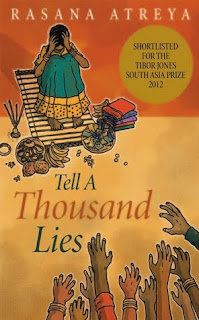Rasana writes:
Early this year the unpublished manuscript of my novel, Tell a Thousand Lies, was shortlisted for the 2012 Tibor Jones South Asia prize. I was ecstatic when I was offered a publishing contract soon after, by one of India’s largest publishing houses. Yet, I declined the offer.Rasana enrolled her book in Amazon's KDP Select program and, while it was free, 17,000 people downloaded it in one weekend! Since then Amazon has changed its ranking algorithm and she has decided to try out Barnes & Noble as well as Smashwords.com. She writes:
Let me explain.
I would have been happy enough to have my paperback published. What I wanted were the rights to my ebook (the electronically downloadable form of a book). I’d been following the career paths of Amanda Hocking and Joe Konrath, the two authors leading the self-publishing charge, and I wanted a chance to apply their marketing methods to my ebooks. The publisher wasn’t agreeable though, so we parted ways, no hard feelings.
If you decide to self-publish, investigate your options carefully. It is easy to get scammed on the Internet. To confuse the issue, a lot of companies are calling themselves self-publishers. Self-publishing is when you upload the book, you set the price, you track the sales, you run the promotions. When someone else does it for you, they are the publisher of record. Horror stories abound about these so-called self-publishers; from manuscripts being stolen, to sales data being fudged, I’ve heard them all.If this seems too intimidating, reputable sites like bookbaby.com can help for a one-time fee. If someone is charging you fees upfront and keeping a cut of your royalties, beware. Reputable publishers will never charge you for publication, which is why they take a cut in your royalties. A quick and dirty way to check if the publisher is legitimate is to look at their website. The focus of a legitimate publisher will be the reader. Their website will be in the business of selling books. A subsidy or vanity publisher’s focus will be you — the gullible writer — and how many unneeded services they can sell to you.I used CreateSpace to publish the paperback in the US (LighteningSource and Lulu are the other options). I’m pleased to report my novel has started to catch the attention of book buyers for public libraries there. My novel shows up on flipkart.com etc. because I had it listed on Ingram’s catalogue, but the international edition is too expensive for India. The time is ripe in India for someone to replicate CreateSpace’s business model, offering printed copies of books for sale, perhaps even distribution to physical and online bookstores.Does this mean I would rule out traditional publishers for my next book? Not at all. I am always open to new experiences.
Further reading:
- Helping Writers De-Stress: Meditation Apps
- Writers: In Order To Win We Must Embrace Failure
- How To Sell 100 Books Per Day: 6 Things You Need To Do


No comments:
Post a Comment
Because of the number of bots leaving spam I had to prevent anonymous posting. My apologies. I do appreciate each and every comment.